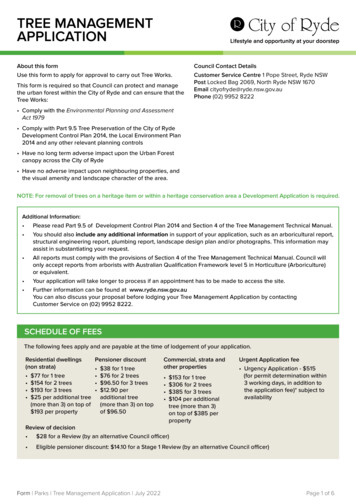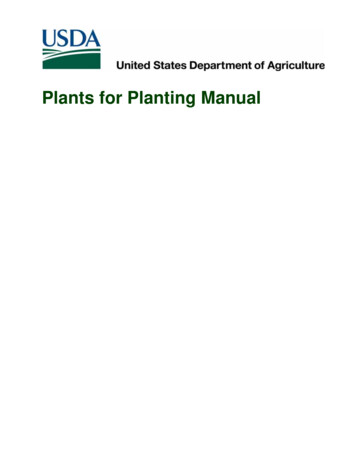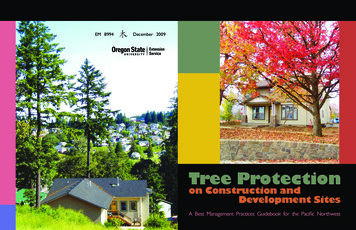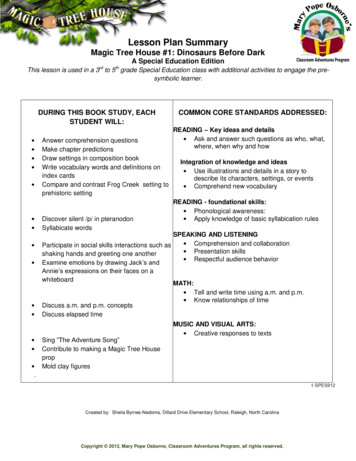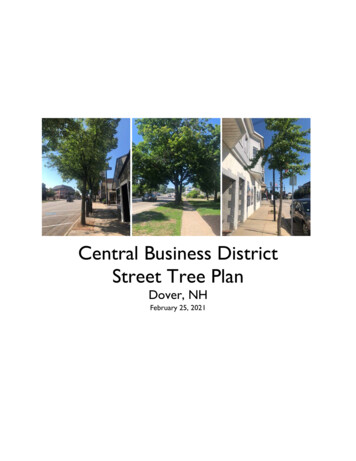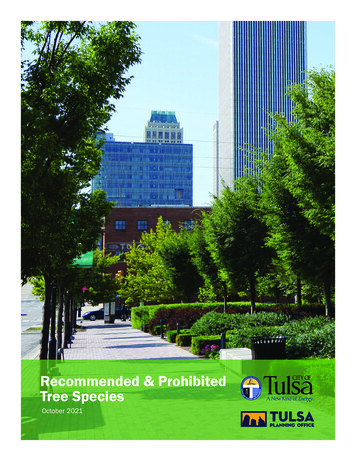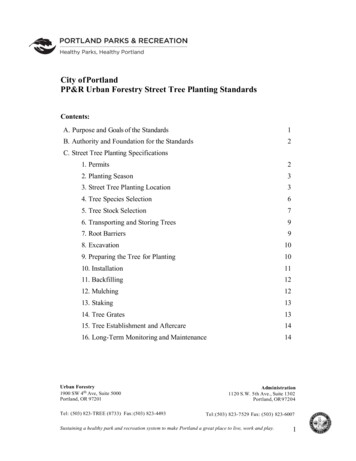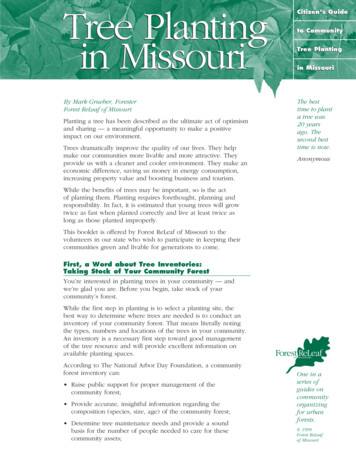
Transcription
Tree Plantingin MissouriBy Mark Grueber, ForesterForest ReLeaf of MissouriPlanting a tree has been described as the ultimate act of optimismand sharing — a meaningful opportunity to make a positiveimpact on our environment.Trees dramatically improve the quality of our lives. They helpmake our communities more livable and more attractive. Theyprovide us with a cleaner and cooler environment. They make aneconomic difference, saving us money in energy consumption,increasing property value and boosting business and tourism.Citizen’s Guideto CommunityTree Plantingin MissouriThe besttime to planta tree was20 yearsago. Thesecond besttime is now.AnonymousWhile the benefits of trees may be important, so is the actof planting them. Planting requires forethought, planning andresponsibility. In fact, it is estimated that young trees will growtwice as fast when planted correctly and live at least twice aslong as those planted improperly.This booklet is offered by Forest ReLeaf of Missouri to thevolunteers in our state who wish to participate in keeping theircommunities green and livable for generations to come.First, a Word about Tree Inventories:Taking Stock of Your Community ForestYou’re interested in planting trees in your community — andwe’re glad you are. Before you begin, take stock of yourcommunity’s forest.While the first step in planting is to select a planting site, thebest way to determine where trees are needed is to conduct aninventory of your community forest. That means literally notingthe types, numbers and locations of the trees in your community.An inventory is a necessary first step toward good managementof the tree resource and will provide excellent information onavailable planting spaces.According to The National Arbor Day Foundation, a communityforest inventory can: Raise public support for proper management of thecommunity forest; Provide accurate, insightful information regarding thecomposition (species, size, age) of the community forest; Determine tree maintenance needs and provide a soundbasis for the number of people needed to care for thesecommunity assets;One in aseries ofguides oncommunityorganizingfor urbanforests. 1999Forest ReLeafof Missouri
Establish the monetary value of community trees andconvincingly show the effects of budgeting and managementon the resource value; and Reveal planting needs and suggest priorities to assure balanceand diversity.You may discover in your research that conducting a treeinventory may take priority over planting more trees. This isnot a daunting task. There are simple inventory techniques thatquickly can provide valuable information. For more informationon how to conduct a community tree inventory, contact theMissouri Department of Conservation.Places to Plant TreesMost community greening efforts take place in parks, schools orcommon grounds, or at government buildings, such as a city hall.They are all excellent planting locations. But take a trip throughyour community and look for areas in need of greening that maynever be considered by anyone else. Note how many areas are indire need of trees. Most communities are unable to plant as manytrees as they remove, often creating large gaps in what could bean oasis of green somewhere in your community. Prime examplesmight include: A vacant lot in a heavily urbanized area A cemetery Public library Public picnic or rest area or historical site Screening a sewage treatment plant or lagoon Streets in the community or town squareConsider locations that are appropriate, yet sorely in need oftrees. The best sites are those where a planting will have a strongvisual impact. If you are having a difficult time with site selection,contact your community leaders and let them provide you withsome inspiration.Once you have selected a spot, it is critical to carefully evaluatethe site before proceeding any further. This is a very importantand often overlooked step, whether the site is a municipal parkor your backyard. Here are some questions that you should askas you consider planting locations:Why am I planting trees at this location?Study your site carefully to determine what will enhance it. Areyou trying to screen an unsightly view; add a splash of color atthe community’s main entrance; or simply want to shade a citystreet? Envision not just the immediate benefits, but what impactsthe trees will have in the future. If your proposed site is publicproperty (park, street right-of-way, school grounds) the property2Citizen’s Guideto Community TreePlanting in Missouri
owner and grounds manager should be involved in this entireprocess from step one. Many planting projects have failed becausethis important interaction didn’t occur. In most instances, theseindividuals will have vital input and be as enthusiastic about theproject as you are.How much space do I need to plant trees?This is where most well-intentioned projects go wrong. Plantingtrees underneath power lines, too close to buildings, next tostreet or commercial signs, or on top of sewer lines costs all ofus millions of dollars every year. Be sure you know the averageheight and width dimensions of the trees you select before youplant (see Suggested Reading on page 16) and without exception,make sure all underground and overhead obstructions areidentified before you decide where to plant. Most utility companieswill be happy to provide information on this topic. And, inMissouri, one phone number will take care of identifying thelocations of all underground utilities: 1-800 DIG-RITE (344-7483).I know trees need water, but how can Iget them what they need?Don’t plan on giving Mother Nature full responsibility for wateringthe trees. She lends a hand now and then, but most often notnearly enough for the first few years of a tree’s life. You mustdesignate a representative who will provide the proper amountfor the tree’s survival. If you cannot ensure this, then your plantingplans should end here period. A convenient water source may bea small pond, fire hydrant, access to a water truck from a publicagency, or the permission of neighbors for use of their spigot.For information on how to water, read on.What other details about the planting sitedo I need to investigate?Soils and drainage: Soils are probably the mostoften ignoredfactor in the site selection process. Because soils in developedareas have been disturbed, they often can be poor for planting.The heavy clay soils commonly found in Missouri drain poorly.Clays compact easily especially with pedestrian traffic or the simpleuse of riding lawn mowers. Dig a few holes around your proposedplanting site to check on soil type. While adding compost or othersoils amendments is helpful for flower beds it is not feasible fortree planting. Consider seeking assistance from your local soil andwater conservation district.Sunlight: There is a definite correlation between the amount ofdirect sunlight at a site and the species that can tolerate it. Forinstance, if your site is in full sunlight, then a flowering dogwoodor other species used to growing in some shade probably won’tperform well. Conversely, there are many species of trees thatcannot tolerate shade. Most evergreens must be planted in fullsunlight. Don’t forget to consider reflected light from varioussurfaces such as sidewalks, streets, and buildings.Citizen’s Guideto Community TreePlanting in Missouri3
Major metropolitan areas are not the only locationswhere trees are affected by chemicals and pollutants. Even thesmallest communities apply de-icers to streets and sidewalksduring the winter. Tree growth is adversely affected by a buildupof salt in the soil as well as airborne chemicals and particulates.Identify any possible pollutant sources that might affect yourplanting site. If even pollution-resistant species would fare poorly,you may need to consider another site.Pollutants:Simply put, humans most often cause declineand death of community trees. Envision the possible uses of thesite and how planting trees will impact those uses. Obviously, thiscan be extremely difficult as our priorities on tree planting maynot match up with someone else’s use for the site. Do your bestto work beforehand with all involved parties in recognizing theissues. You’ll find far more support — and success — for yourtree planting projects.Human activities:Be sure you have good informationabout your planting location such as your area’s hardiness zone orcommon pests. Hardiness zones provide information on theaverage maximum and minimum temperatures your area willendure. This will help you narrow down your list of appropriatespecies. (Make sure your information is specific to Missouri.)Environmental factors:We’ve given you lots to consider. But there’s even more.The Kansas City StoryJust as Kansas City residents were putting out pumpkins forHalloween a few years ago, it hit. The October snowstorm took atremendous toll on the community’s trees.Many trees had not yet lost their leaves. Snow coated those leaves,making the load so heavy that branches broke, limbs ripped apartand some trunks even toppled.Among the trees particularly vulnerable were species that areunsuitable for Missouri weather, and those that had not beenproperly maintained.“In areas where there were more brittle species, poorly formedtrees or trees that had been topped recently, those trees showeda very big problem with the snow. Neighborhoods that hadstreets lined with sweetgums, for instance, were devastated,”says Jerry Monterastelli, an urban forester with the MissouriDepartment of Conservation.The storm was a cold wake-up call from Mother Nature on theimportance of selecting the right kind of tree for planting, andtaking good care of it once in the ground.Species Selection: What Will You Plant?A tree’s ability to thrive in Missouri’s climate is one factor toconsider in choosing a tree, but there are many others. One ofthe best ways to select the species to fit your site is to create your4Citizen’s Guideto Community TreePlanting in Missouri
ideal list of trees using a tree reference guide. List those speciesthat appeal to you under three categories: shade trees, ornamentals,and evergreens. Make sure your list is lengthy. Don’t limit yourselfwith the notion that there is only one “perfect” species for you tochoose. Some suggested references are listed on page 16.Next, run each species through the following series of questions tosee how each tree fits your project goals. You’ll “weed out” someof your selections for one reason or another as they don’t suityour priorities for the planting site. Again, don’t pare your list downto just one selection. Diversity is the key to a successful planting.Before making final decisions, talk to a professional to learn moreabout species. Some of the many available resources are an arborist,the staff at your local garden center, Forest ReLeaf of Missouri ora forester with the Missouri Department of Conservation.How will this tree look when it’s fully grown?Like people, trees come in a variety of shapes and sizes. Combinethe mature shape — columnar, vase-shaped, conical, globe-shaped,broad spreading or oval, to name a few — with its ultimate size,and you’ll choose a tree that can enhance your landscape. Forinstance, you might select a small spreading tree under a powerline or a narrow, tall tree between two buildings. Remember toconsider a tree’s mature shape and height, not the way it lookswhen young.What does this tree look like?Seasonal color: Consider designingyour planting for year-roundeffect. Fall color can be very visually pleasing. People will drive formiles to see a spectacular display of sugar maples. However, thereare other visual characteristics besides foliage. Look at the peelingbark of a river birch or a shagbark hickory and note the texture.Imagine the stark red fruit of a Washington hawthorn against asnowy winter landscape.All trees bear flowers and fruit. Consider theirimpact, positive or negative. For instance, mass plantings offlowering ornamental species like dogwood, redbud, or hawthorncan attract tourism. Flowering dogwoods abound in Camdentonwhere the whole community celebrates the start of spring — andthe arrival of dogwood blossoms — with a festival. However, somespecies, while attractive, can detract from aesthetics or pose a safetyissue, such as dropping seeds or fruit to create a slippery walkway.Practicality must prevail.Flowers or fruits:I want quick shade. How fast does this tree grow?This is often an overrated factor in species selection. Everyonewants instant mature growth and the ability to immediately enjoythe fruits of their labor. We’re here to tell you it’s worthwhile to bepatient. Most fast growing species are weak-wooded (silver mapleis a great example) and have relatively short life spans. If quickshade is a must, be sure to mix slower growing and more sturdyspecies so the shade will last. It may take a little while longer forCitizen’s Guideto Community TreePlanting in Missouri5
the slower growers to catch up, but they will — and yourcommunity forest will be far better with them.I hear this term “hardy” all the time.What does it mean, exactly?Hardiness is a tree’s ability to survive in the normal range oftemperatures of a specific geographic region. The U.S. Departmentof Agriculture has maps that show hardiness zones based uponaverage annual minimum temperature. According to the USDAmap, Missouri ranges from zone 5 in the north to zone 6b alongthe Missouri-Arkansas border. Trees that are hardy only to zone 7will not be very successful in Missouri. Most tree books list whereeach species is hardy. Check to make sure your selections will dowell in your area.I want to plant a problem-free species. Are there any?There is no such thing as a problem-free tree. Every tree canbe susceptible to a particular insect or disease problem. Nativespecies — those that naturally grow in Missouri’s forests — aretypically more resistant to pests and severe climatic conditions.Research the issues commonly related to your possible treeselections through tree reference guides and professionals.Every tree has its disadvantages. The Bradford pear and thesilver maple grow quickly but are prone to breakage from windor ice. Crabapples are lovely but very maintenance intensive.Goldenraintree has ornamental summer flowers and fruit but canspread beyond its desired location. The sweetgum has brilliant fallcolor but produces seed balls that can make walking in thevicinity hazardous. Make sure you’re aware of these issues asthey relate to your site.Planning Your Planting: A Special EventAfter selecting site and species, you will need to plan theplanting logistics. Gathering project support, raising moneyand volunteers, promoting your event, and identifying projectneeds takes as much planning as selecting the right species forthe right site. (To assist you, these topics are fully explored inForest ReLeaf’s guides to community tree planting as a specialevent and fundraising.)Purchasing and Inspecting Your TreesTo give your planting the best chance for success, you shouldobtain the best product to fit your needs. Take heart. There area wide variety of choices available for you in purchasing yourplanting stock. Purchase your plants from a reputable nursery.Nurseries that are members of the American Association ofNurserymen or the Missouri Association of Nurserymen comehighly recommended.6Citizen’s Guideto Community TreePlanting in Missouri
Take your list of desired trees to a nursery or garden center to seewhat is available. Describe the planting site or ask a representativeto visit the site with you. A willing professional might be able tooffer alternatives you had not considered.Mostpeople want the biggest plant they can possibly afford. While thedesire is understandable, larger plants are much more expensiveand difficult to handle. More importantly, the larger the tree, thelarger the shock to its root system when dug, resulting in muchpoorer survival rates or poor plant vigor until adequate roots areregenerated. A plant under stress is much more susceptible toattack by insects and disease. You’ll also find that your choice ofspecies becomes more limited as you increase tree size. Someplants are more difficult to transplant than others, especiallyabove 11 2"-2" in caliper (trunk diameter).A word of advice: Don’t get caught in the size game.Forest ReLeaf considers trees in the range of 11 2"-2" caliper thebest of both worlds. Species availability is good, transplant shockis reduced, the plant usually can be handled by two people, and itprovides immediate effect. All growth factors being equal, a 11 2"-2"caliper tree will typically attain mature size faster than treestransplanted at 3" caliper and greater.If you must plant large trees, consider the following: Absolutely pledge to do post-planting maintenance. A treetransplanted at a smaller size will tend to overcome transplantshock more quickly and be more “forgiving” if an occasionalwatering day is missed. Set a maximum size limit of 21 2"-3" caliper (diameter). This willgive you a lot in the way of immediate effect, provide you witha fair plant selection, and keep transplant losses manageable. Plant only as many large trees as absolutely necessary. Usesmaller plant material to “fill in” where immediate effect is notas important.Be wary of places that want to sell plants only because they are instock. It’s best to move on rather than purchase an alternativeyou’re not comfortable with.You’ll want to visually inspect your planting stock before you buyit. Always reserve the right to not accept a tree that you feel hasproblems. Many nurseries will allow you to select a tree by tyinga colored ribbon on it while it’s still growing in the field.As you inspect your plant material — whether growing in the fieldor on the sales lot — here are some things to look for:Crown/Branches Well-balanced or near symmetrical shape Single, well-developed, central leader (main stem) Plump, healthy-looking budsCitizen’s Guideto Community TreePlanting in Missouri7
Branches well-distributed around and considerably smallerthan the trunkMax. height Free of abnormality caused by insect, disease orphysical defect.Avg. height Word of caution: Avoid trees that have been “headed back,”the undesirable practice of pruning off the ends of thebranches. While this causes the tree to “fill out,” it alsoprevents it from developing into its natural form.Min. heightTrunk Free of cuts or scrapes and all pruning wounds should be“healing” nicely Tapered, especially at the base. Straight Free of abnormality caused by insect or disease11 2" caliper20" widediagram ARootsRoots Adequate, healthy roots for the size of the plant. TheAmerican Standards for Nursery Stock suggest that the rootball (or container size) should be 12" in diameter for every1" of trunk diameter. (See diagram A) Soil and roots joined tightly togetherTrees sold at commercial nurseries are transplanted in threedifferent ways: containerized (in a plastic, cardboard, or woodcontainer), balled and burlapped (b&b), and bare root. How theroots are packaged has some influence on the size of the tree(at the time of purchase) as well as the handling and plantingtechniques.Bare RootSmaller trees are typically sold bare root, which means the soilaround the roots is removed before packaging. The trees arestored in dormancy in cool, moist refrigerated rooms to preventthe root systems from drying. (See diagram B)Trees sold in this manner are usually of smaller sizes rangingfrom seedlings (6" in height) to a 1" caliper (diameter) tree thatmay be as tall as 6'-8'.diagram BBare Root SeedlingsWhat to look for: Moist, fibrous roots For deciduous seedlings up to 10" in height: rootsapproximately equal to the stem length; from 12"-24": rootsapproximately 10"-12" long.Advantages Generally cost less than container and b&b trees Typically less transplant shock and better survival rates8Citizen’s Guideto Community TreePlanting in Missouri
Disadvantages Careful storage is mandatory to prevent root drying Longer term storage (over 1 week) dramatically increases therisk of plant death Planting must be completed before the tree’s dormancy ends Lack of availability of larger sized bare root stockContainerized StockContainerized (or potted stock) is increasing in popularity astechniques improve for growing this type of plant. Typically thetree is grown in a container from its emergence from the seed.As the plant increases in size, it is moved into incrementallylarger-sized containers. Traditional containers are made from blackplastic. You may find variations, such as biodegradable cardboardor burlap (or other fabric) bags. (See diagram C)diagram CContainerized StockWhat to look for Firmly attached to soil while in the container A soil ball that remains mostly intact when removed fromthe container A healthy root system that is not container rootbound. Todetermine this, gently remove the plant from its container andlook for large roots that circle the inside of the pot. Do notpurchase a plant that has roots wider than a pencil thicknessencircling the container’s interior.Advantages Can be planted beyond plant dormancy with a better chanceof survival Easy to handle and store Better long-term storage; requires less maintenance thanbare root or b&b Wide availability of sizes The best survival rates of all types (if planted correctly) Plastic containers can be returned to the nursery or recycledDisadvantages Root circling (girdling) with trees left in containers too long Increased planting time because containerized plants should beroot pruned before planting Soil mixes in containers can be “too rich” and discourage rootsfrom spreading into the surrounding soil. (Can be preventedwith good planting techniques.) Dark-colored containers can heat up in sunlight and kill smallabsorptive rootsCitizen’s Guideto Community TreePlanting in Missouri9
Balled and BurlappedMost landscape size trees are sold in this manner. The trees areharvested from a nursery field by machine or by hand. Improvedmethods in developing root systems are increasing the amount ofroots remaining in the root ball after harvest. (See diagram D)What to look for A recently harvested tree, preferably not stored over summeror winter Roots not loose from the soil ball (the trunk should not appearloose from the soil) Natural burlap fabric rather than synthetic plastic burlap Burlap that is not torn, loose or otherwise damageddiagram DBalled andBurlapped (B&B) A wire “basket” around the burlap root ball to lessen damagefrom handlingAdvantages Easier transplantation of large size trees Good transplantation success rate Widely available and easy to findDisadvantages Much of the root system is lost or damaged during theharvesting and transplanting process Root balls can be heavy and difficult to handle withoutproper equipment Controversy surrounding wire baskets as to whether rootsare girdled by the wire before decompositionIt is best to have unbiased expert advice as you select yourplanting stock. Check with the Missouri Department ofConservation, local extension service, or a forestry (orhorticultural) consultant.Handling TreesThe slogan “Handle With Care” commonly seen on shipping boxesshould be stamped on trees. Poor handling is one of the leadingfactors in the death of newly transplanted trees.Bare root seedlings are the easiest to handle, provided the rootsystems are not allowed to dry out in any way. Containerizedplants are also fairly easy, as long as the plant is picked up by thecontainer. Never pick up the plant by the trunk, no matter howmuch easier it seems. B&b trees are by far the most difficult tohandle. The average weight of an 8' to 10' balled and burlappedtree is 130 pounds! Because most of the weight is in the bulkyroot ball, the tree should always be carried by the root ball.Under no circumstances should the tree be carried by thetrunk! This very common mistake often results in the death of10Citizen’s Guideto Community TreePlanting in Missourithe
tree as the roots are literally torn away. Tell your supplier thatyou will reject any plants that are handled improperly andimpress upon your volunteers the importance of careful handling.(See diagram E)It’s best to get assistance in handling b&b trees. You may beable to have the supplier place the plants next to their plantinglocation or gain the use of a front end loader and operator froma municipal street or parks department. If these are unavailable,rent a dolly or ball cart, which is a specialized dolly made forcarrying b&b trees.wrongStoring TreesAvoid storage if at all possible. Try to plant the trees as soon asyou receive them. Trees that are freshly transplanted from thenursery to the growing site have a much better chance of survivalthan those that are stored for any length of time. Although it canbe difficult due to weather conditions, plan your planting event asclose to the date of delivery as you can.rightdiagram EHandling TreesIf storage is inevitable, use an organic mulch to thoroughly coverb&b and containerized trees. Bare root trees can be stored in arefrigerator. Never store in a freezer! Check the root system oftenand keep the roots moist.PlantingThe 50 tree in the 5000 holeWe’re finally ready to dig a hole! It may seem the least technicalpart of the planting process, but a poor planting job can spelldisaster no matter how much effort you’ve gone through.First, make sure you have the proper tools for the job. A good“round point” spade or shovel works best. You may want to have“sharpshooter spades” or picks on hand for difficult soils. For largescale planting projects, consider having the holes dug by a tractormounted auger.It is important to dig wide holes, whether your trees are bare root,containerized or b&b. The width of the hole should be at leastthree times the diameter of the root spread (if bare root) or rootball. Not only does this encourage rapid root growth beyond theroot ball, it eases soil compaction and allows for thoroughbackfilling of the hole. Intimate contact between the soil and theroots is vital for the tree’s survival. (See diagram F)dug orrototilledareaslopingsides2-5 timesdiameterof rootballfirm subsoil to prevent settlingdiagram FPlantingThe depth of the planting hole will depend on the drainage ofthe soil. However, the depth should never be greater than whatis needed to provide a thin (1 8") layer of soil over the root ball.In most community parks or similar planting areas, soils arecompacted and drain poorly. It is best to dig a more shallow holeand leave the root ball at a slight elevation above the surroundingsoil. The back fill can be mounded slightly to prevent the plantinghole from becoming a bath tub. In this case, it is vital that the treeCitizen’s Guideto Community TreePlanting in Missouri11
be adequately mulched immediately after planting to prevent theroot ball from drying. Trees should be placed in the hole and,if necessary, adjusted to prevent leaning. (See diagram G)Considered the easiest to plant. However, it isalso easy to do a poor job in the process.Bare Root Trees:stakes(opt.)Container Trees: Any non-biodegradable container should beremoved prior to planting. The root ball should then be slashedwith a sharp knife to prevent girdling roots from forming. Largercircling roots can be cut with a pruners. Cardboard containersshould be slashed with a sharp knife to encourage immediateroot growth beyond the root ball.ties(opt.)mulchlayerrootballgrade levelbackfill soildiagram GPlantingDo not remove the natural burlap. Doing so injures the rootsystem as soil collapses around it. Once the tree is properlypositioned in the hole, unwrap or (untie) the burlap from aroundthe trunk and peel back the top so that the soil is exposed. Youmay have to remove pinning nails from the burlap in order topeel back the burlap as well. Cut all strings or ropes — organic orsynthetic — immediately. Although organic rope decays, thisprobably will not happen before the tree begins to increase ingirth. Don’t strangle the tree!B&B:BackfillingUse twoopposing,flexibleties whennecessaryKeep mulch1-2" backfrom trunkgently packbackfill,using waterto settlesoil aroundroot balltrunkflare2-4" layerof mulchcut burlap andrope awayfrom top thirdof root ballset ball onfirmly packedsoil to preventsettlingdiagram HBackfillingIt is best to backfill with the same soil that came from the hole.Adding soil amendments can discourage roots from spreading intothe surrounding soil and eventually strangle the tree. If the soil isso poor that you feel soil amendments are necessary, move thetree to another location.Never stomp or tamp the backfill to firm it. Doing so compacts thesoil. To remove large air pockets, back fill about 1 3 of the hole andthen water the soil thoroughly. You’ll notice considerable settlingas the water is absorbed. If you have enough soil, createa basin by building a small ring around the tree at the hole’sedge to collect water and let it slowly soak into the soil.(See diagram H)Watering and MulchingWatering is the single most important factor in minimizingtransplant shock. Consider that as much as 95% of a root system islost in a b&b tree. Whatever type of plant material chosen, thetree will be in shock, water absorption will be slow andavailability is critical.A slow, trickling hose is the best way to get water to a tree. Letthe water soak in for 30 minutes then move the hose to makesure you have covered the entire planting area. If this is notfeasible, two five-gallon buckets of water poured slowly into thebasin you have created is adequate. Be careful not to overwaterthe tree. Too much water will kill a newly planted tree.12Citizen’s Guideto Community TreePlanting in Missouri
Applying mulch at the time of planting will reduce competitionfrom weeds or grass, retain soil moisture and moderate soiltemperatu
use of riding lawn mowers. Dig a few holes around your proposed planting site to check on soil type. While adding compost or other soils amendments is helpful for flower beds it is not feasible for tree planting. Consider seeking assistance from your local soil and water conservation district. Sunlight: There is a definite correlation between .
